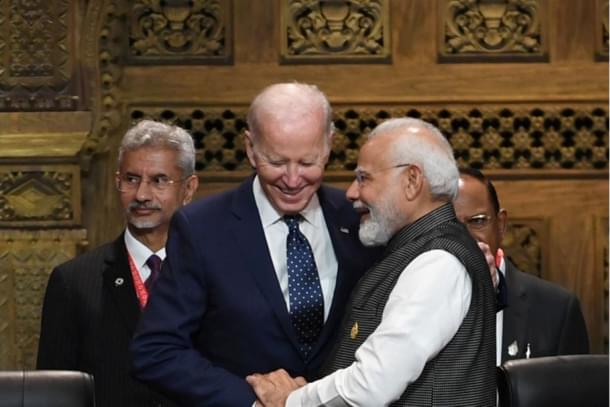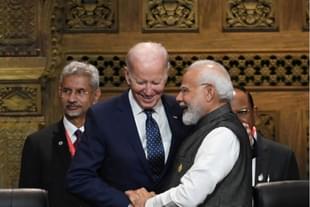Economy
India's Economic Growth Is Key To Future Of Indo-American Ties
Pratim Ranjan Bose
Jun 16, 2023, 03:47 PM | Updated 03:50 PM IST
Save & read from anywhere!
Bookmark stories for easy access on any device or the Swarajya app.


Historically, the US-China relationship had a direct or indirect bearing on the India-US partnership, and Delhi always ensured its policy neutrality.
And even though bilateral relations between India-US should get stronger after Prime Minister Narendra Modi’s state visit to America this month — particularly with anticipated breakthroughs in the defence sector — the ground rules may not shift much.
China is likely to continue to act as a backdrop and India-US ties are unlikely to replace the India-Russia relationship in the foreseeable future.
Improving Fundamentals
The current phase of India-US bonhomie has its roots in Bill Clinton’s visit to India in 2000. It was the first presidential visit since 1978. The intermittent period saw the normalisation and strengthening of the US-China relationship.
According to the US State Department’s admission during 1978-2000, “India was not seen in Washington as an essential and cooperative part of the solution to many major international problems.” Naturally, they didn’t think twice to impose a sanction against India in 1998.
The bilateral relations have come a long way since. All governments in Delhi contributed positively to it and all were mindful to extract the best for the country, without compromising the independence of Indian foreign policy.
Atal Bihari Vajpayee avoided the temptation to join the reconstruction of Afghanistan militarily. India focused on infrastructure building in the war-torn country instead. In 2008, Manmohan Singh signed the civil nuclear deal, an agreement of favourable terms, and marked an end to the isolation.
The relationship took a decisive turn, through the 2016 military logistics deal. India’s decision to join the Quadrilateral Security Dialogue (QUAD) and the US-led Indo-Pacific Framework for Prosperity (IPEF) etc, added to the momentum.
The period coincided with Beijing’s aggressive foreign policy, stiff opposition by the Modi government on China’s unilateral claims and advances (including the China-Pakistan Economic Corridor) and, worsening China-US relations. The rise of the China-Russia axis is the latest addition to this list.
Economy At The Centre
Many interpreted the growing India-US partnership as an end to Delhi’s policy neutrality. The myth was broken by India’s recent decision to step up the purchase of cheap crude oil from Russia post-Ukraine crisis, ignoring strong resentment from America.
India’s growing economic prowess, particularly in the post-Covid period when almost every other major economy is witnessing recessionary trends, added depth to the bilateral relation.
The recent order by Air India for purchase of 220 aircraft from Boeing made US President Joe Biden ecstatic. According to an official statement from the White House, it will help create “over one million American jobs across 44 states”.
What is true for the USA is also true for the struggling European Union. Air India placed an order for 250 aircraft from Airbus. And, they are not the only Indian airlines that are going out shopping. IndiGo placed an identical purchase order.
In a parallel development, Apple Inc’s decision to relocate part of the iPhone14 production line to India was a major boost to Modi’s ‘Make-in-India’ campaign. It increased the country's ranking among global businesses that are looking to diversify their supply chain from China.
Apple is scheduled to produce 7 per cent of iPhones in India in 2023. According to a recent report, the share may go up to 18 per cent in 2025. Notably, Apple is betting big on domestic sales in India. The two Apple stores grossed Rs 44-50 crore revenue in the first month of operation.
New Phase Begins
Seen from this light, there is enough logic in favour of US Secretary of State Antony Blinken’s remarks that economic ties are at the heart of the India-US strategic partnership.
Economic ties were also at the heart of the once-thriving US-China relationship. The professional, academic and technical exchanges between the two nations far outstripped the exchanges between India and the US.
And, until recently, the American industry was one of the biggest supporters of the single-party regime in Beijing. American media used to write eloquent copies on China. ‘Democracy’ or lack of it, was out of the narrative.
No Western media issued advertisements seeking anti-CCP (Chinese Communist Party) or anti-Xi (Jinping) correspondents in China as New York Times did in India recently.
By any standard, India is now exactly where China was in the end-1990s or early 2000s before they started flexing muscle. The job at hand is, therefore, to make the most of the current wind and create an adequate mass of interest groups abroad, who will speak for India.
There is no better vehicle than the US to reach this goal. Part of it has already begun. Some American lawmakers recently questioned their government about why Indians have to wait for up to two years to get an American visa.
We might see more in this direction during the state visit. American universities may set up campuses in India. The US may allow some white-collar jobs to go to India for the sake of business efficiency.
Win-Win
Wider India-US cooperation is a win-win for both. The more their economy is malfunctioning, the more the Xi Jinping administration in Beijing is getting more belligerent, probably to earn respect at home.
They are unlikely to get into a full-scale war. But, a series of unprovoked incidents like the Doklam stand-off in 2017 and the Galwan Valley clash in 2020 make many believe that more may be waiting to happen in India’s northern border.
The lack of modernisation of Indian armed forces in the past gives China a definite advantage. People’s Liberation Army (PLA) has more than double the number of fighter jets.
The much-anticipated deal for General Electric to manufacture light combat jet engines in India will, therefore, help Delhi to roll out Tejas aircraft in greater numbers. The US will gain a foothold in India’s fighter aircraft market.
There is every possibility that this tie-up will evolve into stronger defence collaboration and more US investment in Indian manufacturing. For that India must keep working to ensure a longer boom run than the one between 2004 and 2008.




